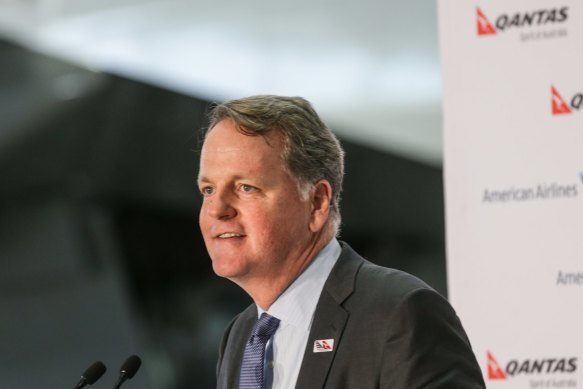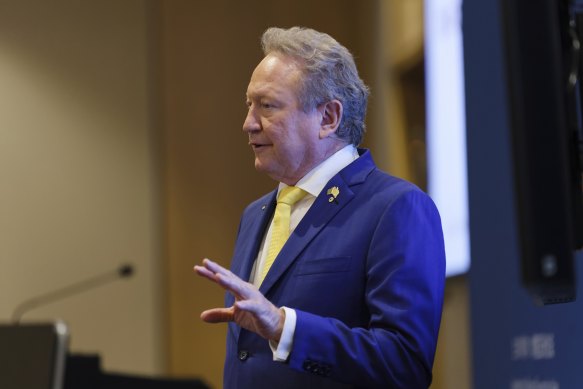By Anne Hyland
Qantas’ shareholders are waiting for the release of the company’s annual report, which will reveal the final compensation package paid to the airline’s former chief executive, Alan Joyce.
Meanwhile, it’s worth revisiting Qantas’ annual report from 2022. In that report, Qantas’ board said that in the 2022-23 financial year, the primary measure for its senior executives’ short-term incentive plan (STIP) would continue to be underlying profit, accounting for a weighting of 50 per cent.
The board then added: “Acknowledging our need to do more to deliver the service our customers expect, the STIP scorecard will also have a higher weighting on customer, and include key operational priorities like net promoter score, external reputation/trust and on-time performance, to align executive incentive outcomes to the customer experience.”

The Qantas scandals have hit the airline’s reputation and brought pressure on members of Qantas’ board, especially chair Richard Goyder, to follow Alan Joyce out the door.Credit: Rhett Wymann
Remember that report was released in September 2022. It’s been well documented that this year has been an annus horribilis for Qantas in terms of its customer service, trust, reputation and on-time performance, although the latter has been improving.
Qantas has been reeling from a $570 million flights credit scandal and is being sued by the Australian Competition and Consumer Commission. The ACCC alleges Qantas sold more than 8000 bogus tickets on flights last year, well after the flights were cancelled, and is seeking fines of at least $250 million.
On Wednesday, Qantas suffered a further blow to its reputation, when the High Court upheld lower court rulings that the airline acted illegally when it sacked 1700 baggage and ground staff during the pandemic. The damages from that High Court decision are to be determined.
How the board addresses those problems remains to be seen. It may potentially strip executives of bonuses or slash them, and the attention is on Joyce’s exit package. To be sure, Qantas executives did meet and exceed their STIP target on earnings, delivering a record pre-tax full-year profit of $2.47 billion.
In the 2021-22 financial year, Qantas’ board suspended the STIP while the airline built up capacity as its planes came out of hibernation post-pandemic. The STIP was replaced by a recovery retention plan.
Even so, in the 2022 annual report the board still provided a STIP scorecard for the 2021-22 financial year. Qantas senior management met, or partially met, all STIP measures, except for customers. On that measure, there was “no achievement against targets”.
It’s worth noting that pre-pandemic in the 2019 annual report, Qantas’ STIP was weighted 50 per cent towards profits, 15 per cent each to customer and safety, and 10 per cent each to domestic market position, and growth or transformation.
The Qantas scandals forced Alan Joyce to retire early, and have hit the airline’s reputation. Now there is pressure on Qantas chair Richard Goyder to follow Joyce out the door. Goyder, so far, has shown no sign of leaving.
He won’t be the only board director under pressure. New appointees, Doug Parker and Heather Smith, will also feel the heat as neither own Qantas shares, based on ASX filings as of Thursday evening.

Former American Airlines chairman and CEO Doug Parker has been a Qantas director since May. He doesn’t own Qantas’ shares.Credit: Dallas Kilponen
Smith, a former federal government Industry, Innovation and Science department secretary, was appointed a Qantas director in August. Parker, a former American Airlines chief executive and chairman, was appointed in May.
Parker could fund the purchase of a few Qantas shares by selling some of his $US36 million ($56 million) in American Airlines stock.
The importance of directors owning shares in companies on which they serve was explained in a recent report by Ownership Matters, a group that provides advice and research to institutional investors on companies and boards. “Investors broadly support the concept of non-executive directors having some ‘skin in the game’ through personal investments in ordinary shares, which provide alignment with shareholders,” said Ownership Matters.
If neither Parker nor Smith own shares by Qantas’ annual general meeting in November, it will be a point of contention with shareholders.
At that meeting, the board might also be questioned about its charter. The first item on that charter is that the Qantas board is responsible for having an appropriate corporate governance structure, which creates and protects shareholder value.
Next, is that the board is responsible for ensuring management recognises their legal and other obligations to all stakeholders. Third, is the board’s obligation to ensure it has appropriate accountability and control systems in place.
The charter provides in detail the board’s responsibilities and duties. Among those are “satisfying itself an appropriate risk management framework exists in relation to financial and non-financial risks and to review, monitor and manage risk”.
In June, Qantas announced new senior management appointments, including the creation of a chief risk officer role. Qantas called it a “new” role. A Qantas spokesman said previously the risk responsibility was shared between John Gissing, the QantasLink chief executive, and the airline’s general counsel.
However, the chief risk officer is not a “new” role but rather back to the future for the airline. The chief risk officer role existed at Qantas in 2011, and was filled by Rob Kella, who is now at Emirates.
By 2012, there was no mention of the chief risk officer role in Qantas’ annual report, despite the position being explicitly mentioned in such reports in multiple prior years.
The 2012 report also had these prescient comments from then chief Alan Joyce: “Financial sustainability is our core goal – building a strong, viable business capable of delivering superior returns for shareholders over the long term. But we cannot achieve this unless we maintain strong governance frameworks, ensure that Qantas is a good place to work for employees and provide world-class service to customers.”
Getting Twiggy with it
Much has been written about the revolving door of senior management at Fortescue Metals Group (FMG) and its green energy subsidiary Fortescue Future Industries. There has been less written about the request made of some departing staff, whether a CEO or a scientist, to sign non-disclosure agreements (NDA).
FMG chief executive Fiona Hick and chief financial officer Christine Morris resigned from the company last month. In a statement, FMG thanked Hick for her “valuable efforts”. In the days that followed, FMG’s executive chairman, Andrew “Twiggy” Forrest, made comments about both women.
He attributed Hick’s departure to differences of opinion over FMG’s green transition, and suggested that staff who left the iron ore miner had struggled to cope with Fortescue’s “boiler room” working environment. Regarding Morris, Forrest said she was “very lucky” to have been appointed CFO, and had “just scraped in over an internal candidate – which was an error”. After their departure, Forrest also said FMG now had a “team of insiders, not outsiders”.
The comments were condemned by other business people as disrespectful. Forrest then said Hick and Morris had his best wishes. “They were good people, but we need constant alignment of interest,” he said.

Andrew Forrest, founder and executive chairman of Fortescue Metals Group. Credit: Trevor Collens
If Hick and Morris were asked to sign NDAs on their exit, then typically such agreements include confidentiality and non-disparagement clauses. That is, after leaving you can’t say anything about the terms of departure or settlement, the reasons for departure, what went on inside the company, its financials, or anything bad about the company or its people, including board and management.
If there were NDAs, should they not also bind FMG, and its founder and executive chair on what he says? Typically, with NDAs the obligations in the contract should mirror one another for each party.
The Australian Council of Superannuation Investors, which represents the nation’s biggest superannuation funds that hold substantial shareholdings in publicly listed companies, has been asking boards if their companies use NDAs, and if so to make available publicly how many NDAs they have instituted on an annual basis.
The Business Briefing newsletter delivers major stories, exclusive coverage and expert opinion. Sign up to get it every weekday morning.